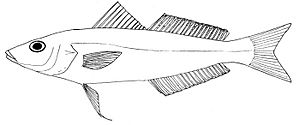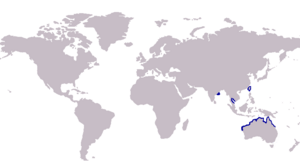Bay whiting facts for kids
Quick facts for kids Bay whiting |
|
|---|---|
 |
|
| Scientific classification | |
 |
|
| Range of the bay whiting | |
| Synonyms | |
|
The bay whiting (Sillago ingenuua) is a type of fish that lives in the ocean near coasts. It belongs to a family of fish called Sillaginidae, also known as smelt-whitings.
You can find bay whiting in the western Indian Ocean. This includes places like northern Australia, Thailand, India, and Taiwan. They like to live in calm, protected waters. This fish usually stays near the bottom of the ocean (that's what 'benthic' means!). It eats small creatures like shrimp, worms (called polychaetes), and molluscs. We don't know much else about its life. Bay whiting are important for fishing in some areas. Both local people and commercial fishermen catch them regularly.
Contents
What is a Bay Whiting?
The bay whiting is one of 29 different types of fish in the Sillago group. This group is part of the smelt-whiting family, called Sillaginidae. Smelt-whitings are a kind of Perciformes fish.
How the Bay Whiting Got Its Name
A scientist named Roland McKay first officially identified and named this fish Sillago ingenuua in 1985. He found the first example of this fish, called a holotype, near Chantaburi in Thailand. This happened in 1975. Before its official name, people sometimes mistakenly called it Sillago argentifasciata.
The name ingenuus comes from Latin and means "freeborn." This name was chosen because the fish was found in Thailand, which is a free country. The common name, bay whiting, simply describes where this fish usually lives: in bays.
What Does a Bay Whiting Look Like?
Like most fish in its group, the bay whiting has a slightly flat, long body. Its body gets narrower towards its mouth. Small, rough scales cover its body and head.
Key Features of the Bay Whiting
The bay whiting has two dorsal fins (on its back). The first dorsal fin has 11 stiff spines. The second dorsal fin has 1 spine and 17 soft rays. Its anal fin (on its belly) is similar, with 2 spines and 17 soft rays.
Other ways to identify this fish include counting the scales along its side. It has between 66 and 70 lateral line scales. It also has a total of 33 vertebrae (backbones). The biggest bay whiting ever found was about 20 centimeters (almost 8 inches) long.
Colors of the Bay Whiting
The bay whiting is usually a pale sandy brown color. It can also be a light fawn color. Unlike some other similar fish, it does not have a shiny silver stripe along its side. All its fins are clear, or hyaline. The pectoral fin (on its side) does not have a dark spot at its base. You can sometimes see the dark brown inside of its gill cover through its almost clear skin. The tip of its nose can sometimes be dark.
Where Do Bay Whitings Live?
Bay whitings are found in different places, but their distribution can be a bit scattered. They live in the Gulf of Thailand, India, Taiwan, and northern Australia. In Australia, they are found from Shark Bay all the way around the northern coast to Adolphus Passage in Queensland.
Scientists think they might live in even more places. However, they are often mistaken for other fish. Also, small local fisheries might not report catching them.
Bay Whiting Habitat
This fish lives in inshore coastal waters. This means they stay close to the shore. They are found at depths between 20 and 50 meters (about 65 to 164 feet). Like many other smelt-whitings, bay whitings are known to live in estuaries. Estuaries are places where rivers meet the sea. However, not much research has been done on exactly what kind of habitat they prefer.
What Do Bay Whitings Eat?
Scientists have studied what bay whitings eat. This helps them understand how these fish fit into the food chain. In the South China Sea, bay whitings mainly eat different kinds of shrimp, polychaete worms, and Mantis shrimp. They also eat smaller amounts of crabs, sea urchins, bivalves, and copepods.
Unlike some other fish, the bay whiting's diet doesn't change much as it grows older. This means adult fish might sometimes compete with younger fish for food. However, their diet is different from another similar fish, Sillago sihama. This helps prevent too much competition between the two species.
Bay Whitings and Humans
People often catch bay whitings. Fishing boats called trawlers catch them off the northwest coast of Western Australia and near Torres Straits in Queensland. This fish is also very important for traditional and smaller commercial fisheries along the Asian coast. People usually sell them fresh in markets.
Sometimes, recreational fishermen catch bay whitings too. The biggest one ever recorded by an angler weighed only about 0.047 kilograms (about 0.1 pounds).
See also
 In Spanish: Silago de bahía para niños
In Spanish: Silago de bahía para niños

